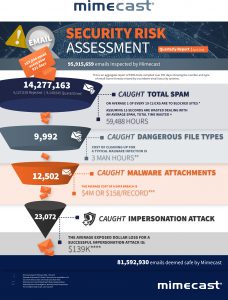Mimecast Limited, a leading email and data security company, has announced the availability of its quarterly Email Security Risk Assessment (ESRA), a report of tests that measure the effectiveness of incumbent email security systems.
It reveals that these systems missed 11,653 emails containing known malware, which should be the easiest to identify, as they are detectable by commonly deployed endpoint-based anti-virus technologies. Additionally, the report noted a continued challenge of securing organisations from unknown malicious attachments, dangerous files types, impersonation attacks and even basic spam.
As part of the assessment, Mimecast inspected more than 95 million emails, all of which had passed through organisations’ incumbent email security vendors. These organisations, in 20 different industries, invested millions of dollars to deploy a variety of commonly used on-premise and hybrid email security systems.
The latest report found a total of 14,277,163 pieces of spam, 9,992 emails containing dangerous file types, and 849 unknown emails with malware attachments — all missed by the incumbent providers and delivered to users’ inboxes. Most notably, 11,653 known emails with malicious attachments passed through these systems, an increase of 532% in comparison to last quarter’s assessment. Impersonation attacks also continue to be a problem for an organisation, as 23,072 were caught – an increase of 22%.

“Mimecast’s ESRA is aiming to establish a standard of transparency that raises the bar for all security vendors helping organisations pinpoint weaknesses in their defences,” said Matthew Gardiner, cybersecurity strategist at Mimecast.
“Emails ranging from opportunistic spam, targeted impersonation attacks and unknown malware are getting through incumbent email security systems. The security system of one primary cloud email platform missed 76.6% of the aggregate impersonation attacks while another global security vendor missed the 83.4% of the “known” malware attachments.”
Mimecast recently conducted global research with Vanson Bourne on the state of organisations’ cybersecurity, what attacks they’ve seen increase and their level of confidence to thwart these evolving attacks.
The findings were based on responses from 800 IT decision makers and C-level executives. Organisations are forecasting a challenging future, with nearly 60% of respondents having said their organisation is likely to suffer a negative business impact because of an email-borne attack in 2018.
Also in line with the ESRA results, despite efforts, email-borne attacks are on the rise. The clear majority of Vanson Bourne respondents have seen untargeted phishing attacks (94%) or targeted spear-phishing attacks (92%) with malicious links in the past 12 months, with the volume of both attacks increasing 56% over the last year. Most respondents also reported seeing email-based impersonation attacks asking either to initiate wire transfers (87%) or for confidential data (85%) over the last year.
“Mimecast’s multilayered security inspection system is engineered to include more than 100 analytic techniques and threat data sources provided both by in-house development and third-party sources, including three separate AV engines, file sandboxing, static file analysis and other techniques,” added Gardiner.
“No single technique can be relied upon to stop the rapidly evolving attacks and organisations need to ensure they also have continuity during and automated recovery after an attack to achieve cyber resilience for email,” Gardiner added.


